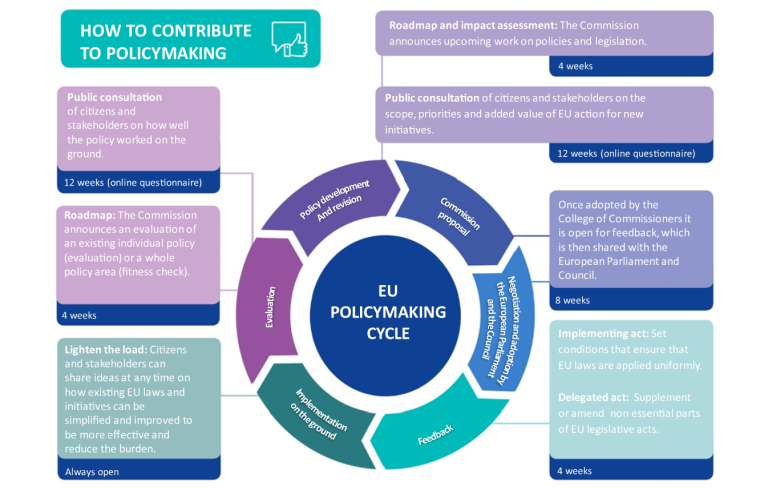From Brussels to the ballot box: Why citizens matter in climate policy
Climate change policy is often discussed in technical terms, emissions trading systems, renewable energy targets, carbon budgets yet the EU’s approach increasingly recognizes that citizens are not just policy recipients but co-designers of the green transition. The European Commission itself has stated that “Game-changing policies only work if citizens are fully involved in designing them.” egmontinstitute.be
Over the past decade, the EU has gradually shifted toward “deliberative democracy”, giving citizens more formal ways to provide input before laws are proposed and enabling more participatory governance in climate matters. greendealnet.eu
How the EU collects citizens’ input
Public feedback in EU policymaking happens via multiple channels:
- Open Public Consultations (OPCs): every major EU initiative includes a consultation process where individuals, NGOs, businesses, and local governments can comment on draft proposals.
The European Commission’s “Have Your Say” portal gathers these consultations and feedback. More than 85% of public consultations are available in all 24 EU languages, and translated versions receive ~35% more responses than English-only versions. have-your-say.ec.europa.eu - The European Climate Pact: initiated in 2020, this is a bottom-up engagement channel where thousands of individuals, communities, and “Pact Ambassadors” take pledges, hold events, share ideas, and interact with the Commission on climate topics. greendealnet.eu
- Citizens’ assemblies / panels / deliberative fora, for example, during the Conference on the Future of Europe, a citizens’ panel addressed climate, environment & health, involving randomly selected citizens from all 27 Member States. Also, France ran the Citizens’ Convention for Climate in 2019–2020 with ~150 citizens (representative across demographics) making emissions, energy, transport, housing proposals.greendealnet.eu
- European citizens’ initiative (ECI) & citizens’ engagement platforms: the ECI allows citizens to propose legislation if they gather ≥1 million valid signatures across at least seven Member States.ec.europa.eu
- The citizens’ engagement platform is a multilingual space for EU-level policy debate and citizen contributions.interregeurope.eu
- National participatory processes linked to climate governance under the Governance Regulation (for National Energy and Climate Plans, NECPs) states are required to include public participation steps in drafting their plans.tandfonline.com

When citizens’ input changes policy
Public feedback has shaped real policy outcomes. Here are some illustrative cases:
- Social Climate Fund (SCF): Concerns raised in public consultations and civil society feedback about affordability and fairness under the ETS2 reforms pushed the Commission to propose a Social Climate Fund of €86.7 billion for 2026–2032 to assist vulnerable households and small businesses. eeb.org
- Strengthening just transition & industrial plans: Worker groups, regional authorities, and civic organizations insisted on linking industrial transition to social protection. The Green Deal’s industrial strategy and Just Transition mechanisms were adapted to explicitly integrate these voices.greendealnet.eu
- Calls for more meaningful consultation in NECPs: Reports from WWF, CAN Europe, and others found that most Member States failed to provide genuine public participation in revising their NECPs, in violation of their obligations under the Climate Governance Regulation and the Aarhus Convention.
- These critiques are pushing for stronger procedural requirements, minimum consultation timeframes, and clearer explanations of how input was incorporated. wwf.eu
- Civil society pressure on consultation quality: NGOs have criticized overly restrictive formats, narrow consultation windows, lack of transparency and responsiveness pressuring the Commission and Member States to improve design and follow-up.caneurope.org
Digital participation and transparency
The Have Your Say platform is central to EU-level participation. It offers multilingual consultation access, feedback, and archival of contributions.ec.europa.eu
The Commission publishes “synopsis reports” after consultations, summarizing how input (from citizens, NGOs, industry, academia) was considered in the final proposal. commission.europa.eu
Policy briefs note that high-quality public participation strengthens both climate outcomes and democratic legitimacy, increasing trust, reducing polarization, and improving fairness.greendealnet.eu
But gaps remain: participation is often imbalanced (stronger from better-resourced organizations), visibility is low, deliberative spaces are limited, and mechanisms are inconsistently applied across EU and national levels.greendealnet.eu
Why public feedback matters beyond policy
Citizen involvement delivers more than better policies, it helps build legitimacy, trust, and resilience in the climate transition:
- According to Eurobarometer / Commission surveys, 85% of EU citizens see climate change as a serious problem, and 81% support the EU’s goal of climate neutrality by 2050.
- Over 88% of respondents back more investment in renewables and energy efficiency.
- Citizens view national governments (66%), the EU (59%), and industry (58%) as key actors in climate action. Climate Action
- When citizens see their contributions reflected in policy, they are more likely to trust the transition, accept trade-offs, and support ambitious targets. Policy briefs argue that well-designed participation reduces polarization and helps avoid backlash.greendealnet.eu
- Early engagement allows detection of local obstacles (grid constraints, social affordability, infrastructure gaps) before policy implementation improving feasibility and social fairness. EEB – The European Environmental Bureau
Looking ahead: From consultation to co-creation
The EU is evolving beyond mere consultation toward co-creation, integrating citizens more directly into policy design, testing, monitoring:
- Projects like the New European Bauhaus bring together citizens, designers, and policy makers to co-design sustainable living spaces.
- Future proposals e.g. the 2040 Climate Target Communication are expected to expand participatory mechanisms, making citizen involvement a permanent pillar of EU climate governance.
Policy briefs suggest concrete steps: institutionalizing participatory mechanisms, ensuring inclusive representation (balancing civil society groups), ensuring transparency, enforcing minimum consultation rules, and combining top-down and bottom-up initiation. greendealnet.eu
Summary
Public feedback is no longer a formality in EU climate policy; it’s becoming a core democratic tool for shaping the green transition. From online consultations and citizens’ panels to local climate missions, millions of Europeans actively influence how the EU reduces emissions, supports vulnerable people, and invests in clean innovation.
The evidence suggests that meaningful citizen participation improves both climate outcomes and democratic legitimacy reducing polarization, increasing trust, and anchoring the transition in lived realities. But participation must be inclusive, well-timed, transparent, and genuinely influential, not merely symbolic.
As Europe moves toward its 2050 climate neutrality goal, the success of that journey will depend as much on listening as on legislating.




